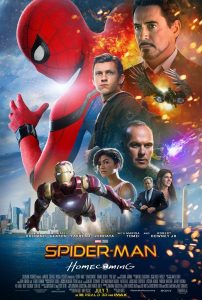DACTS News
Hours
| 2022 | |
| Monday: | Closed |
| Tuesday: | Closed |
| Wednesday: | Closed |
| Thursday: | Closed |
| Friday: | Closed |
| Saturday: | Closed |
| Sunday: | Closed |
Speaking & Writing Centers can help |
|
Week 3: Design Tips in Action
Posted on: Sep 29, 2017
We’ve spent the last couple posts talking about how to design successfully, highlighting things like repetition, contrast, alignment, and color theory. This week though, I want to show you those things, and what better way to do that than with the seemingly ubiquitous comic book movie! Now, I’m not actually going to use any clips from the various movies (check back in later if you’re interested in video though; I’ll blow you’re mind a little bit), but I am going to talk about a couple of movie posters from Spiderman: Homecoming that really exemplify what to do and what not to do.

“Spiderman: Homecoming” Poster
First, let’s take a look at this early poster for the movie. It looks good, right? Like something about it is just pleasing to the eye? Well, that’s because it employs some basic principles really well, and it keeps the poster relatively simple. It has a bold diagonal alignment and it carries that throughout the poster, so that even though it’s technically off-center, nothing looks out of place or disorganized. It also recognizes the impact of color, which is why there is so much blue in the poster. That blue keeps the red and yellow in the poster from being too warm or overwhelming to the eye. Then there’s the inclusion of yellow in the first place, which isn’t part of Spiderman’s canonical costume, but still gets incorporated here because that trio of primary colors (red, yellow, blue) has a specific rhetorical connotation, in that it’s associated with children’s toys and various other childhood ephemera. This film returns the character of Peter Parker to high school and because that was something they wanted to emphasize in their marketing, they chose this color scheme.

“Spiderman: Homecoming” Poster #2
Now, let’s look at the second poster. It’s kinda of a hot mess, don’t you think? A lot of that has to do with it ignoring the principles we just talked about. Take alignment, for instance; there’s a million things going on and it looks disorganized as a result. On the right side, characters are stacked on top of one another, and on the left, they can’t even maintain a clear division from the frenetic action on the other side, which would of at least helped the overall design aesthetic. Besides being messy, this design is also overwhelming to us, something that is only made worse by its color choices. Instead of incorporating blue or some tint or shade of it to calm things down, we instead get bright purple next to bright orange next to red, resulting in an image that is too warm and consequently even more overwhelming. Of course, the final problem is that the poster fails to tell us anything about the movie on a thematic level, which is both a result of the design choices and likely also why those choices were made in the first place; because the artist (or graphic designer) didn’t know what they were trying to say.
I hope this foray into movie posters helped you understand some of the principles we’ve been talking about in a more concrete way, and be sure to check back next week, when we’ll dip our toes into video!
Image Credit
“Spiderman: Homecoming Posters.” Jo Blo Movie Network. 2017. http://www.joblo.com/movie-posters/2017/spider-man-homecoming#image-34131





